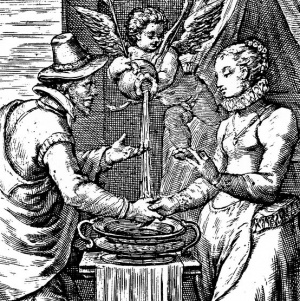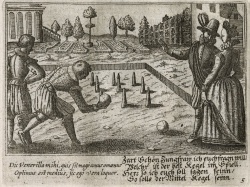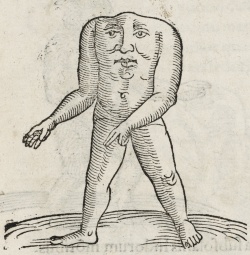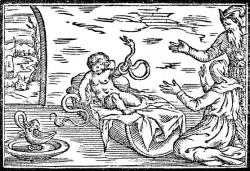Seeing What Shakespeare Means

Seeing What Shakespeare Means, part of the Exhibitions at the Folger opened April 3, 1999 and closed on August 21, 1999.
Understanding Shakespeare's language is not always easy. Four hundred years of "static" intervene between his writing and our reading and hearing. While most of Shakespeare's immense vocabulary is still in use, and many ideas and figures to which he refers are still part of our culture, some of his words and references seem foreign to us. Fortunately, books from Shakespeare's time contain woodcuts and engravings that give us ways of literally seeing what Shakespeare means. This exhibition drew from the Folger's rich collections of early books, highlighting images that illuminate Shakespeare's text and that have been used to aid readers of the Folger Shakespeare Library editions of Shakespeare's works.
Only through pictures can we visualize many of the objects, places, pastimes, and customs of Shakespeare's everyday life. These include the male attire of doublet and hose, the cattle markets of Eastcheap, and the sports of bearbaiting and bowls. Pictures also let us see how Shakespeare and his contemporaries imagined the world. Their education was very different from our own, with their time in school devoted almost exclusively to the classics — texts in Latin and Greek that often featured mythological subjects. It was thus natural for Shakespeare to present or allude to the harpy and the phoenix, Leander and Hercules, Cupid and Diana, whose images appear in the exhibition. Pictures also illuminate much of the conventional wisdom quoted in Shakespeare's plays. We can understand many of Shakespeare's lines with lightning speed if we have the right visual images before us — if, for example, we can see the figure of Time as he "goes on crutches" or see a picture of the world "going on wheels." This exhibition presents a sample of the Folger's vast holdings of the visual arts of Shakespeare's day and thus makes visible much of Shakespeare's remarkable language.
Exhibition material
Visualizing Shakespeare
One way in which illustrations inform our readings of Shakespeare is by helping us visualize the objects, places, and customs of his day that are no longer familiar. Sometimes Shakespeare refers directly to such things; at other times, as in the case of the doublet and hose, Shakespeare uses the everyday reference to illustrate a figurative idea.
Punishment
Measure for Measure
- Marrying a punk, my lord, is
- pressing to death,
- whipping, and hanging. (5.1.596–597)
To drive home his dismay at being forced to marry the prostitute ("punk") he has impregnated, Lucio compares his fate to the worst kinds of punishment he can imagine. The first example he gives, pressing to death, was a form of torture in which the body of an accused person who refused to speak was crushed under a mass of stones.
Sports

Richard II
- Queen: What sport shall ... drive away the heavy thought of care?
- Lady: Madam, we'll play at bowls.
- Queen: 'Twill make me think the world is full of rubs
- And that my fortune runs against the bias (3.4.1–5)
Richard's Queen desires some diversion to make her forget her cares. She rejects the suggestion of a game of bowls, punning on rub (an obstruction that deflects the course of the bowl) and bias (the curve that brings the ball to the desired point).
Julius Caesar
- . . . we are at the stake
- And bayed about with many enemies. . . . (4.1.52–53)
Bearbaiting was a bloodsport in which dogs attacked a bear chained to a stake. Extremely popular in Shakespeare's time, the sport took place in market squares, village greens, and in urban arenas such as the famous Paris and Bear Gardens on London's Bankside, where Shakespeare's Globe was also located. At least one theater, the Hope, which opened on the Bankside in 1614, was used both for playing and bearbaiting.
Clothes
As You Like It
- I could find in my heart to disgrace my man's apparel and to cry like
- a woman, but I must comfort the weaker vessel, as doublet and hose
- ought to show itself courgeous to petticoat. (2.4.4–7)
Doublet and hose, typical male attire consisting of a close-fitting jacket and breeches, here stands for the male as petticoat stands for the female.
Twelfth Night
- I could be sad. This does make some obstruction in the blood, this
- cross-gartering, but what of that? (3.4.21–23)
Cross-gartering, the fashion of wearing ribbons tied round the knees, is mentioned nine times in Twelfth Night, all in relation to the duping of Malvolio, whose normal attire is sober and unadorned. After looking at the picture, one can see why Malvolio speaks of the style's potential for causing discomfort.
Love & Marriage
- . . upon a true contract
- I got possession of Julietta's bed.
- . . . she is fast my wife. . . .
- Measure for Measure (1.2.142–144)
In Shakespeare's time, couples who clasped hands and exchanged vows before witnesses performed a ceremony called handfasting, after which they were widely regarded as legally married.
Entertainment
- Prince: Where sups he? Doth the old boar feed in the old frank?
- Bardolph: At the old place, my lord, in Eastcheap.
- Henry IV, Part II (2.2.145–147)
Eastcheap was an area of London filled with markets and taverns. Prince Hal's humorous description of Falstaff as "the old boar" is the nearest Shakespeare comes to specifying the favorite haunt of Hal, Falstaff, and company as the celebrated Boar's Head Tavern in Eastcheap.
War
- For 'tis the sport to have the engineer
- Hoist with his own petard.
- Hamlet (3.4.229–230)
A petard was a military explosive, a small cone-shaped bomb used to breach a gate or wall.
Imagining Shakespeare
As an age of exploration and discovery, the Renaissance was awash in the marvelous: the wonders of nature itself, of the strange practices and customs of newly discovered worlds, of the individual's fantastic imaginings, and of the characters and strange creatures brought into the public consciousness through the period's immersion in classical mythology. Shakespeare's plays offer us a window into this imaginative world of the Renaissance. Images depicting these strange creatures, stories, and characters help us to understand the imaginative context of the plays and the world in which they were written.

Othello
- The Anthropophagi, and men whose heads
- Do grow beneath their shoulders. These to hear
- Would Desdemona seriously incline. (1.3.166–170)
Images from Lycosthenes' appropriately entitled Prodigiorum (of Prodigies or Wonders) depict one of the strange sights Othello encountered in his travels. Tales of these and other marvelous beings comprise the whole of the "witchcraft" with which Othello confesses to having captured Desdemona's heart. Surprisingly, the same set of images — cannibals, anthropophagi, and men with heads beneath their shoulders — appears in the play and on a single page of the Prodigiorum.
The Tempest
- . . . Now I will believe
- That there are unicorns, that in Arabia
- There is one tree, the phoenix' throne, one phoenix
- At this hour reigning there. (3.3.26–29)
In The Tempest, Sebastian wryly recalls this aviary wonder to express amazement at the "strange shapes" bringing in a mysterious banquet to him and his shipwrecked mates. No sooner do several of the crew take up the invitation to eat and drink than Ariel appears to them as a harpy, a mythological creature with the face and breasts of a woman and the wings and talons of a bird, and makes the food and drink vanish. This incident is modeled on stories from the Argonautica and Aeneid of harpies destroying or devouring the food of starving travelers. The passage quoted here is actually a rather striking stage direction.

Love's Labor's Lost
- He shall present Hercules in minority. His enter and
- exit shall be
- strangling a snake. (5.1.133–135)
Classical mythology constitutes the single most important body of material that Shakespeare drew upon in constructing his plays. Whether used for comic, ironic, or tragic effect, Shakespeare's many allusions to mythology introduce us to words and images that significantly enlarge the scope and widen our perspective of the plays. Hercules was a mythological character of whom Shakespeare made frequent use. In this image, the hero is depicted as a child, strangling the two snakes sent to destroy him. Shakespeare's recurring use of images of Hercules reminds us that mythological characters were part of the common currency of language in his day.
Much Ado About Nothing
- Leander the good swimmer. (5.2.30–31)
In Greek mythology, Leander was a famous lover who drowned while swimming across the Hellespont to see his sweetheart Hero. In Much Ado About Nothing, Benedick claims that Leander's suffering as a lover is nothing as compared to Benedick's own where Beatrice is concerned. Shakespeare's characters frequently refer to Leander's exploits as a standard measure of romantic devotion.
Richard III
- . . . fair St. George
- Inspire us with the spleen of fiery dragons. (5.3.371–372)
While Shakespeare's allusions to mythology are most often classical, at times he drew upon non-classical myths and native folklore, calling up memories of the legendary King Arthur or heroic St. George. King Richard, as he prepares for the battle at Bosworth Field, calls upon England's patron saint and dragon slayer, asking for an infusion of the dragon's courage ("spleen") for himself and his men.
Understanding Shakespeare
Visual images can illustrate not merely objects, places, or stories, but also abstract ideas and popular beliefs. The images reproduced here exemplify Shakespeare's creative use of figurative language and, in particular, of three rhetorical devices: personification, proverb, and metaphor. In personification, human attributes are ascribed to non-human creatures or inanimate objects. Proverbs distill common experience into a compact and memorable formula. And metaphor is a comparison that identifies one thing with another, dissimilar thing. All of these help explain the strange by using the familiar, challenging the reader with the power of their resonance.
Look at a few examples from the plays to see what Shakespeare really means:
Antony and Cleopatra
- . . . Fortune break her wheel. (4.15.52)
The Roman goddess Fortuna, personifying chance, distributes good and bad luck as she chooses. She is often pictured with an incessantly turning wheel, drawing a person up to a position of power and then casting him down again. The regulation of human destinies by Fortune's wheel was a popular conception even before Shakespeare's time.
In King Lear, the villainous Edmund, sensing death is near, uses the image of Fortune's wheel to indicate his awareness that he is again at the bottom of the rotation, where he began as a bastard. In Antony and Cleopatra, the Egyptian queen rages against Fortune when faced with Antony's imminent death, commanding the goddess to "break her wheel" and keep Cleopatra's lover alive. In The Winter's Tale, Perdita, euphoric in her love for Florizell but anxious about the difference in their social status, invokes Fortune's aid in bringing the couple happiness.
For more on Fortune, visit the page on the Folger exhibition Fortune: All is But Fortune.
King Lear
- May not an ass know when the cart draws the horse? (1.4.229–230)
Here Shakespeare draws on the proverb "To set the cart before the horse." The Fool comments on the role-reversal taking place as Lear's daughter scolds her father for misbehaving. Just as it is absurd to imagine a cart pulling a horse, the Fool implies that it is absurd for the parent to be chastised by the child.
Love's Labor's Lost
- The shape of love's Tyburn, that hangs up simplicity (4.3.52)
Tyburn was a place of execution in London. The picture shows Cupid torturing a foolish lover. Berowne uses the metaphor of the gallows to argue that love "hangs up" foolishness, mocking his three perjured friends, who have broken their vows to forgo the company of women. The picture is a vivid representation of love's pain.
Much Ado About Nothing
- In time the savage bull doth bear the yoke. (1.1.256)
This proverbial line claims that even the person most resistant to Love's arrow will eventually succumb and bear the yoke of matrimony. Here, Don Pedro predicts that the fierce woman-hater Benedick will one day be Cupid's victim. Benedick had earlier attacked marriage by saying he would never thrust his neck into a yoke.
The image of Cupid yoking an ox by Philipp Ayers informs our reading of Shakespeare's language on many levels. First, it simply shows us a "yoke," an object which might be unfamiliar to modern readers. It also provides us with a visual representation of Cupid, the Roman god of love. But beyond these functions, this image helps us to visualize Shakespeare's figurative language. Not only does it show us a "savage bull" bearing a yoke, but the inclusion of Cupid suggests that this is a yoke of love or marriage. When we put together this text and this image, we can see what Shakespeare means.
Othello
- If that the earth could teem with woman's tears,
- Each drop she falls would prove a crocodile. (4.1.274–275)
Once again drawing on the proverbial, Shakespeare alludes to the crocodile's supposed ability to shed false tears that would evoke sympathy from its intended victim. After verbally and physically abusing Desdemona, Othello accuses her of shedding hypocritical tears. But tragically, it is Iago who has entrapped him with false and misleading suggestions about Desdemona's fidelity.